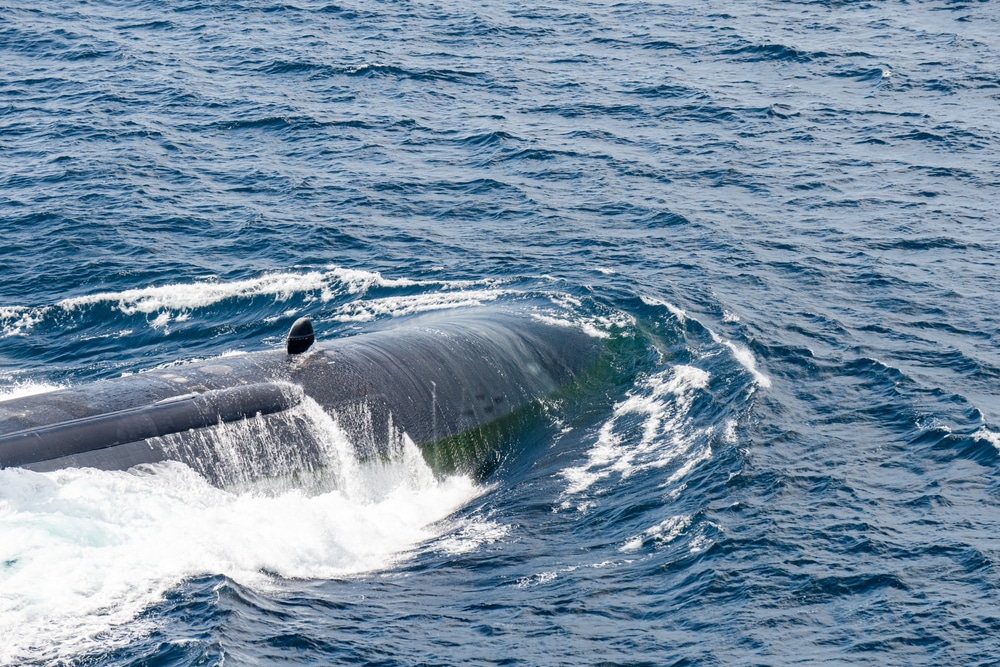The USS Baltimore (SSN-704) was a U.S. Navy nuclear-powered attack submarine that was part of the formidable Los Angeles class fleet. While the vessel boasted cutting-edge technology, crew members who served aboard faced significant health risks from substantial quantities of asbestos used in building it. This exposed personnel to the potential for being diagnosed with mesothelioma, lung cancer, asbestosis, and other life-threatening diseases.

A Los Angeles-class Attack Submarine
The USS Baltimore belonged to the Los Angeles class of submarines, which were designed to replace the aging Sturgeon-class submarines and enhance anti-submarine warfare effectiveness. This family of attack submarines countered underwater threats from the Soviet Union during the Cold War and became the backbone of the Navy’s undersea warfare strategy throughout the late 20th century.[1]
Measuring approximately 360 feet in length with a beam of 33 feet and a displacement of over 6,900 tons, the Baltimore had a sleek hull design that enabled superior maneuverability with a minimal acoustic signature, ideal for covert operations. Powered by a 26MW General Electric PWR S6G nuclear reactor that generated 35,000 shaft horsepower, the submarine could achieve speeds of 32 knots and remain submerged for extended periods without surfacing. The Baltimore carried a complement of 12 officers and 115 enlisted personnel who operated the vessel’s complex systems and weapons.
The Los Angeles-class submarines had impressive tactical capabilities. They were armed with approximately 25 torpedo tube-launched weapons, allowing them to engage both surface vessels and enemy submarines. The vessel also carried Mark 67 and Mark 60 CAPTOR mines for strategic deployment. Her armament included Tomahawk cruise missiles with ranges reaching 2,500 kilometers for land-attack missions, as well as Harpoon anti-ship missiles capable of delivering 225-kilogram warheads at targets up to 130 kilometers distant.[2]
About the USS Baltimore (SSN-704)
Construction and Commissioning
The contract to construct the USS Baltimore was awarded to the Electric Boat Division of General Dynamics Corporation in Groton, Connecticut, in October 1973. Her keel was laid down in May 1979, and she was launched in December 1980, with Congresswoman Marjorie S. Holt serving as sponsor. The vessel was named to honor Baltimore, Maryland, and was the sixth ship in U.S. Navy history named to recognize the city’s importance to America’s naval heritage.
Entry into Naval Service
In July 1982, the USS Baltimore was formally commissioned at a ceremony held at the Naval Submarine Base New London in Groton, Connecticut. Following commissioning, the USS Baltimore conducted extensive shakedown operations and training exercises on the submarine’s sophisticated weapons systems, navigation equipment, and engineering plants to prepare for operational deployment.[3]
Global Presence and Strategic Missions
The Baltimore’s anti-submarine warfare capabilities allowed effective detection and tracking of enemy submarines, and this was frequently deployed throughout her years of active service. From 1982 to 1998, she participated in deployments to the Mediterranean Sea, Persian Gulf, Western Pacific, and other strategically vital areas, using her state-of-the-art sonar systems for intelligence gathering operations. She also conducted show-of-force missions that demonstrated American resolve and military capability.
Combat Operations and Conflict Participation
The USS Baltimore served during a pivotal period in American military history, the Gulf War. In 1991, nine Los Angeles-class submarines were deployed to the region, and while specific details of the Baltimore’s participation remain classified, it’s known that she contributed to the mission’s success.
During March and April 2003, the vessel supported Operation Iraqi Freedom along with eleven other Los Angeles-class submarines deployed to the region. These vessels, collectively armed with Tomahawk land-attack missiles, conducted precision strikes against targets inside Iraq.
Recognition and Awards
The USS Baltimore was recognized for operational excellence and mission accomplishment with Battle Efficiency Awards. These competitive awards reflected the dedication and professionalism of the crew in maintaining the vessel’s complex systems and executing challenging missions.
Individual crew members aboard the Baltimore also received commendations, including the Navy and Marine Corps Achievement Medal and Navy Commendation Medal, recognizing exceptional performance, technical expertise, and leadership that contributed to the submarine’s success and reputation within the fleet.
Technological Capabilities, Systems, and Modernization
The USS Baltimore’s cutting-edge technology featured a Raytheon CCS Mark 2 combat data system that integrated weapons control, target tracking, and tactical information display. This system enabled coordinated operations with other naval assets by providing real-time situational awareness and improved decision-making capabilities during complex missions. She was also equipped with 12 dedicated vertical launch system tubes that allowed Tomahawk cruise missile launches without using torpedo tubes, thereby maintaining full torpedo loadout availability while conducting strike missions.[2]
Throughout her service life, the Baltimore underwent periodic upgrades to maintain technological relevance. Engineering system improvements enhanced reliability and operational efficiency. Navigation system modernization provided greater accuracy and capability in diverse operating environments. These continuous improvements ensured the submarine remained an effective platform despite advancing technology and evolving threats, but also exposed shipyard workers and technical personnel involved in the upgrades to asbestos within the vessel’s structure and the equipment itself.
Propulsion and Engineering Systems
The submarine’s nuclear reactor provided virtually unlimited operational range, delivering pressurized hot water to steam generators that produced steam to drive turbines and generators for propulsion and electrical power. This feature, which distinguished nuclear submarines from conventional diesel-electric designs, eliminated the need for a main drive shaft. The equipment, much of which was contaminated with asbestos, was primarily manufactured by General Electric (GE) and Curtiss-Wright.
The Baltimore used an electrolytic oxygen generator that separated water molecules into hydrogen and oxygen: The oxygen sustained the crew while hydrogen was expelled from the vessel. This system, though essential for long-duration missions, required careful monitoring due to potential fire or explosion risks. The submarine also carried an auxiliary diesel generator for emergency power or ventilation in case of fires or other events. Though the Baltimore’s operational protocol called for a gradual warm-up, the commanding officer could authorize immediate full-power loading when needed.
Decommissioning and Final Disposition
The USS Baltimore was decommissioned and stricken from the Naval Vessel Register in July 1998, after approximately 16 years of active service. The decision to retire the submarine came as part of the Navy’s fleet modernization strategy, with newer submarines entering service to replace the earlier Los Angeles-class boats. After decommissioning, the vessel was scheduled for disposal through the Nuclear Powered Ship and Submarine Recycling Program at Puget Sound Naval Shipyard in Bremerton, Washington.
Asbestos Contamination Aboard the USS Baltimore
The U.S. Navy relied on asbestos-containing materials in virtually every vessel constructed or modernized from the early 1900s through the mid-1970s, encompassing the entire construction period of the Los Angeles-class submarine program. Military planners considered asbestos indispensable for protecting vessels and personnel, particularly valuing its heat resistance, fire protection, and insulation properties.
Submarines like the USS Baltimore presented unique environmental challenges that made asbestos seem essential. The confined spaces, sealed atmosphere, and complex mechanical systems created elevated fire risks and needed superior thermal and flame protection. Asbestos’s fibrous structure, combined with its durability, heat resistance, and sound-dampening characteristics, made it ideal for numerous applications.
Despite growing scientific evidence documenting asbestos’s severe health consequences, military contracts continued specifying the toxic material be used well into the 1970s. The Navy began restricting asbestos in new construction around 1973, with its use in ship components largely eliminated by 1975. However, vessels already under construction or in service retained their asbestos-containing materials until they could be addressed during scheduled maintenance or removed upon decommissioning. This included the USS Baltimore.
Locations of Asbestos Throughout the Submarine
The Navy ordered that asbestos be used wherever thermal protection, fire prevention, or insulation was needed, and it was found in nearly every compartment and system aboard the USS Baltimore. The extensive distribution created hazards for anybody exposed to it, but especially to those whose work put them in areas with significantly higher concentrations of the dangerous fibers. These included:
- Engineering and Reactor Spaces
The reactor compartment, machinery rooms, and auxiliary equipment areas required extensive protection from extreme temperatures for both equipment safeguarding and personnel safety. Piping systems, exhaust components, and equipment throughout these spaces contained asbestos, and essential valves, pumps, and fittings relied on asbestos gaskets and packing materials to maintain pressure integrity and prevent system leaks. Turbine components and reactor shielding also incorporated asbestos for thermal and radiation protection.
- Living and Working Quarters
Crew berthing areas and command spaces were far removed from the contaminated engineering spaces, but they too contained asbestos in floor tiles, wall panels, ceiling materials, and protective coatings. Additionally, electrical systems that ran throughout the submarine depended heavily on asbestos-containing wire insulation, and distribution cables, control panel components, and emergency equipment all used asbestos for temperature and flame protection. Additionally, as asbestos particles became airborne through manipulation, damage, or deterioration, they were transported into these living areas on the clothing, skin, and hair of crew members and through the vessel’s ventilation system.
- Ventilation and Environmental Systems
The submarine’s atmospheric control networks were critical for maintaining breathable air in the sealed environment. Unfortunately, asbestos insulation and asbestos-containing filtration components meant these systems distributed deadly fibers throughout the vessel’s atmosphere. Particles, released through normal system operation, maintenance activities, and equipment aging, were continuously recirculated for crew members to breathe.
- Weapons Systems and Specialized Equipment
Thermal protection and fire resistance were particularly important in missile compartments and for weapons systems. Insulation blankets, padding materials, and adhesive compounds used in these areas all contained asbestos, and torpedo tubes and associated equipment also incorporated contaminated components for operational safety and equipment protection.
Personnel Most at Risk for Exposure
Every sailor serving aboard the USS Baltimore faced asbestos exposure risks. The material’s pervasive presence throughout the submarine, combined with the sealed environment and continuously recycled atmosphere, meant microscopic asbestos particles circulated constantly through all compartments. These particles were disturbed by maintenance activities, equipment operation, and routine daily tasks.
Submarine crews confronted unique dangers compared to personnel aboard surface vessels. Patrol periods that were extended by the Los Angeles-class’s superior technologies meant crew members remained submerged for months at a time, eliminating any possibility for fresh air ventilation or asbestos particle escape. The constantly recycled atmosphere and prolonged exposure duration elevated every sailor’s risk substantially. However, certain ratings and duties faced heightened exposure due to their responsibilities and work locations. These included:
- Nuclear and Propulsion Personnel
Nuclear technicians, reactor operators, and propulsion specialists worked directly with heavily insulated reactor systems and engineering equipment, performing maintenance that required cutting, grinding, or removing asbestos-containing insulation, gaskets, and components.
- Electricians and Electronics Technicians
These specialists encountered exposure while working with electronic components containing asbestos materials, disturbing asbestos-containing electrical insulation, working with distribution networks, and servicing control systems throughout the submarine.
- Weapons and Fire Control Personnel
Torpedomen, missile technicians, and fire control specialists worked in compartments where asbestos materials were integral to equipment operation and safety systems.
- Supporting Ratings
Auxiliary personnel, including damage control technicians, machinery repairmen, and hull technicians, encountered asbestos during maintenance and repair activities throughout the submarine.
Even crew members not directly involved in maintenance were exposed through contaminated clothing worn by messmates, through ventilation systems distributing particles throughout the vessel, and through asbestos materials present in general living and work spaces.
Compensation and Support for USS Baltimore Veterans
Many Navy veterans who served aboard the USS Baltimore have developed asbestos-related diseases. A recent diagnosis can feel overwhelming, but numerous resources and options exist for affected veterans, including substantial compensation and specialized medical treatment.
Veterans Administration Benefits
The Department of Veterans Affairs provides comprehensive benefits for veterans with service-connected asbestos-related conditions. Veterans diagnosed with mesothelioma, lung cancer, or asbestosis may file claims for disability compensation, specialized medical care, and additional family benefits. The VA recognizes mesothelioma as a service-connected condition for veterans with military exposure and classifies it as 100% disabling. This designation ensures expedited claims processing and maximum compensation levels.
The VA maintains specialized treatment centers with expertise in asbestos-related diseases. These facilities provide cutting-edge medical care, access to clinical trials, and coordinated treatment planning. Veterans may also receive travel reimbursement, caregiver support, and dependent benefits based on their specific circumstances and needs.
Legal Action Against Manufacturers
Beyond VA benefits, veterans diagnosed with asbestos-related illnesses may qualify to pursue legal claims against manufacturers and suppliers of asbestos-containing products used aboard their vessels. Although the Navy and federal government cannot be sued, private companies that produced asbestos materials can be held accountable. Litigationfiled over recent decades has resulted in substantial settlements and jury verdicts compensating for medical expenses, lost income, pain and suffering, and other damages.
Successful cases have been brought against companies that manufactured insulation, gaskets, valves, pumps, and other asbestos-containing materials found aboard submarines like the USS Baltimore. These legal actions do not affect veterans’ eligibility for VA benefits, allowing veterans to pursue both sources of compensation at the same time.
Asbestos Trust Fund Claims
Asbestos trust funds represent another significant source of economic security for affected veterans. Companies that manufactured asbestos-containing items or parts established these funds specifically to compensate victims diagnosed with asbestos-related diseases following exposure to their products. The trusts have distributed billions of dollars in claims already, with approximately $30 billion reserved for future claimants.
Trust fund claims offer several advantages. The process is typically faster than litigation, reducing stress for seriously ill claimants. Multiple trusts can be pursued simultaneously, potentially increasing total compensation, and trust fund claims can be filed alongside VA benefits and legal actions, maximizing available recovery options.
Help for USS Baltimore Veterans with Mesothelioma
Seeking compensation for the damage caused by asbestos illnesses involves complex legal issues and procedural requirements. Veterans who need more information should consult with an attorney specializing in mesothelioma litigation. These knowledgeable professionals have dedicated their practices to helping individuals affected by asbestos from occupational and military exposures.
Experienced mesothelioma attorneys understand the unique requirements of documenting naval service exposure. They can identify potentially responsible parties and available compensation sources, coordinate comprehensive legal strategies combining lawsuits and trust fund claims, and assist with VA claims filing and appeals.
Statutes of limitations are legally imposed deadlines that apply to many types of court filings, including asbestos-related claims. They make contacting an attorney quickly after diagnosis essential to giving them adequate time to gather service records, medical documentation, and other evidence necessary for building strong cases. With proper legal representation, veterans sickened by asbestos aboard the USS Baltimore can successfully access the benefits and compensation they deserve for their service-related illnesses.
References
- Sea Forces Online. (N.D.). Los Angeles-class Attack Submarine.
Retrieved from: https://www.seaforces.org/usnships/ssn/Los-Angeles-class.htm - 19 Forty Five. (September 2022.). Los Angeles Class: Is the Navy Making a Mistake Retiring These Submarines?
Retrieved from: https://www.19fortyfive.com/2022/09/los-angeles-class-is-the-navy-making-a-mistake-retiring-these-submarines/ - Navy Emporium. (N.D.). USS Baltimore SSN-704
Retrieved from: https://www.navyemporium.com/blogs/navy-blog-articles/uss-baltimore-ssn-704?srsltid=AfmBOoorADul9jNJFuZ8DrQyz7IDvEAWjHCzhaN4XjupSc2isssTaJpF

Terri Heimann Oppenheimer
WriterTerri Oppenheimer has been writing about mesothelioma and asbestos topics for over ten years. She has a degree in English from the College of William and Mary. Terri’s experience as the head writer of our Mesothelioma.net news blog gives her a wealth of knowledge which she brings to all Mesothelioma.net articles she authors.

Dave Foster
Page EditorDave has been a mesothelioma Patient Advocate for over 10 years. He consistently attends all major national and international mesothelioma meetings. In doing so, he is able to stay on top of the latest treatments, clinical trials, and research results. He also personally meets with mesothelioma patients and their families and connects them with the best medical specialists and legal representatives available.


